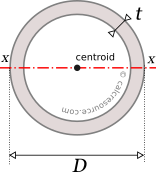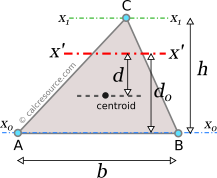
We can estimate the second moment using squares, but it is very inaccurate: Estimation of 2nd Moment of Area. In the field of structural engineering, the second moment of area of the cross-section of a beam is an important property used in the calculation of the beam's deflection and the calculation of stress caused by a moment applied to the beam. It is also called the area moment of inertia. This value is equal to the product of the objects mass and the square of the objects perpendicular distance from its rotational axis. The calculated results will have the same units as your input.


It is a scalar value which tells us how difficult it is to change the rotational velocity of the object around a given rotational axis. Enter the shape dimensions b, h and t below. Rotational inertia is a property of any object which can be rotated. Its unit of dimension when working with the International System of Units is meters to the fourth power, m4. This tool calculates the moment of inertia I (second moment of area) of an angle. In both cases, it is calculated with a multiple integral over the object in question. With this moment of inertia calculator, you can calculate the second moment of area of many common shapes. The second moment of area is typically denoted with either anįor an axis that lies in the plane or with aįor an axis perpendicular to the plane.

The 2nd moment of area, also known as moment of inertia of plane area, area moment of inertia, or second area moment, is a geometrical property of an area which reflects how its points are distributed with regard to an arbitrary axis. If the mass is released from a horizontal orientation, it can be described either in terms of force and accleration with Newtons second law for linear motion.


 0 kommentar(er)
0 kommentar(er)
